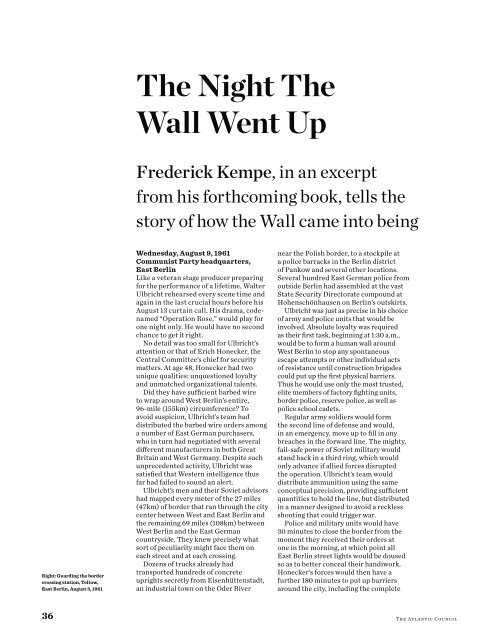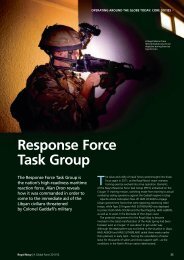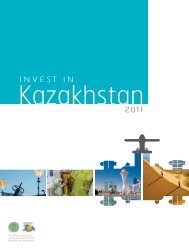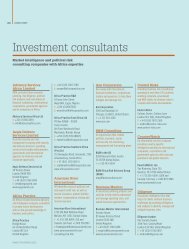NATO – A Bridge Across Time - Newsdesk Media
NATO – A Bridge Across Time - Newsdesk Media
NATO – A Bridge Across Time - Newsdesk Media
You also want an ePaper? Increase the reach of your titles
YUMPU automatically turns print PDFs into web optimized ePapers that Google loves.
Right: Guarding the border<br />
crossing station, Teltow,<br />
East Berlin, August 3, 1961<br />
The Night The<br />
Wall Went Up<br />
Frederick Kempe, in an excerpt<br />
from his forthcoming book, tells the<br />
story of how the Wall came into being<br />
Wednesday, August 9, 1961<br />
Communist Party headquarters,<br />
East Berlin<br />
Like a veteran stage producer preparing<br />
for the performance of a lifetime, Walter<br />
Ulbricht rehearsed every scene time and<br />
again in the last crucial hours before his<br />
August 13 curtain call. His drama, codenamed<br />
“Operation Rose,” would play for<br />
one night only. He would have no second<br />
chance to get it right.<br />
No detail was too small for Ulbricht’s<br />
attention or that of Erich Honecker, the<br />
Central Committee’s chief for security<br />
matters. At age 48, Honecker had two<br />
unique qualities: unquestioned loyalty<br />
and unmatched organizational talents.<br />
Did they have sufficient barbed wire<br />
to wrap around West Berlin’s entire,<br />
96-mile (155km) circumference? To<br />
avoid suspicion, Ulbricht’s team had<br />
distributed the barbed wire orders among<br />
a number of East German purchasers,<br />
who in turn had negotiated with several<br />
different manufacturers in both Great<br />
Britain and West Germany. Despite such<br />
unprecedented activity, Ulbricht was<br />
satisfied that Western intelligence thus<br />
far had failed to sound an alert.<br />
Ulbricht’s men and their Soviet advisors<br />
had mapped every meter of the 27 miles<br />
(47km) of border that ran through the city<br />
center between West and East Berlin and<br />
the remaining 69 miles (108km) between<br />
West Berlin and the East German<br />
countryside. They knew precisely what<br />
sort of peculiarity might face them on<br />
each street and at each crossing.<br />
Dozens of trucks already had<br />
transported hundreds of concrete<br />
uprights secretly from Eisenhüttenstadt,<br />
an industrial town on the Oder River<br />
near the Polish border, to a stockpile at<br />
a police barracks in the Berlin district<br />
of Pankow and several other locations.<br />
Several hundred East German police from<br />
outside Berlin had assembled at the vast<br />
State Security Directorate compound at<br />
Hohenschönhausen on Berlin’s outskirts.<br />
Ulbricht was just as precise in his choice<br />
of army and police units that would be<br />
involved. Absolute loyalty was required<br />
as their first task, beginning at 1:30 a.m.,<br />
would be to form a human wall around<br />
West Berlin to stop any spontaneous<br />
escape attempts or other individual acts<br />
of resistance until construction brigades<br />
could put up the first physical barriers.<br />
Thus he would use only the most trusted,<br />
elite members of factory fighting units,<br />
border police, reserve police, as well as<br />
police school cadets.<br />
Regular army soldiers would form<br />
the second line of defense and would,<br />
in an emergency, move up to fill in any<br />
breaches in the forward line. The mighty,<br />
fail-safe power of Soviet military would<br />
stand back in a third ring, which would<br />
only advance if allied forces disrupted<br />
the operation. Ulbricht’s team would<br />
distribute ammunition using the same<br />
conceptual precision, providing sufficient<br />
quantities to hold the line, but distributed<br />
in a manner designed to avoid a reckless<br />
shooting that could trigger war.<br />
Police and military units would have<br />
30 minutes to close the border from the<br />
moment they received their orders at<br />
one in the morning, at which point all<br />
East Berlin street lights would be doused<br />
so as to better conceal their handiwork.<br />
Honecker’s forces would then have a<br />
further 180 minutes to put up barriers<br />
around the city, including the complete<br />
36 The Atlantic Council







